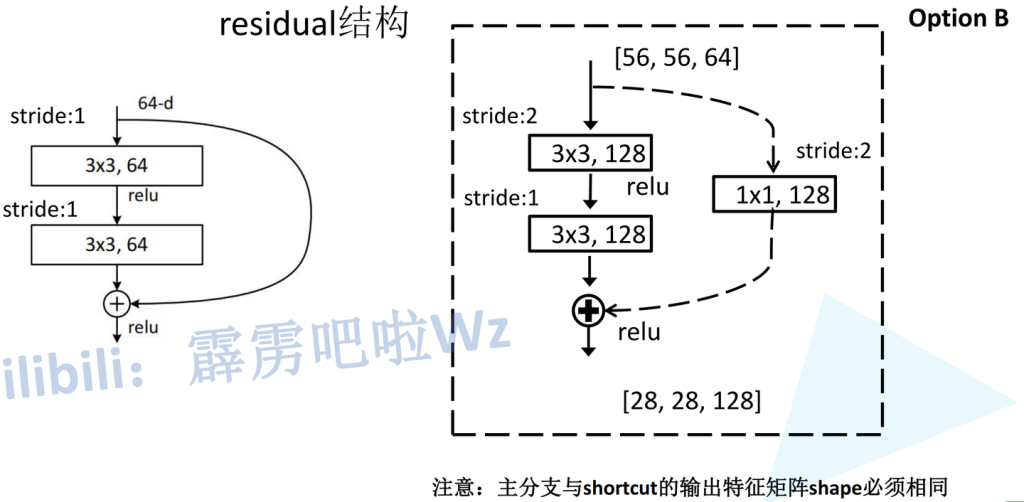Residual connection 残差连接学习
训练神经网络的一个困境是,我们通常希望更深的神经网络具有更好的准确性和性能。然而,网络越深,训练就越难收敛。这一点困扰着层数深的模型,不过Kaiming He提出的Resnet创新性的使用的残差skip的方法,有效解决了这样的极深网络的问题。
网络过深时会出现以下问题:
- 梯度消失或梯度爆炸:以梯度消失为例,反向传播过程中,每向前传播一层,都要乘以一个小于1的误差梯度。解决梯度消失或梯度爆炸的方法有:对数据标准化处理;权重初始化;Batch Normalization(BN)
- 退化问题(degradation problem):ResNet主要解决退化问题,提出残差结构
在传统的前馈神经网络中,数据顺序地流过每一层:一层的输出是下一层的输入。它有隐患,一旦其中某一个导数很小,多次连乘后梯度可能越来越小,这就是常说的梯度消散,对于深层网络,传到浅层几乎就没了。但是如果使用了残差,每一个导数就加上了一个恒等项1,dh/dx=d(f+x)/dx=1+df/dx。此时就算原来的导数df/dx很小,这时候误差仍然能够有效的反向传播,这就是核心思想。
Residual Connection通过跳过某些层为数据到达神经网络的后面部分提供了另一条路径。考虑一系列层,从层 i 到层 i + n,设 F 为这些层所表示的函数。用 x 表示层 i 的输入。在传统的前馈设置中,x 将简单地一个接一个地通过这些层,并且层 i + n 的结果是 F(x)。绕过这些层的剩余连接通常按以下方式工作:

剩余连接首先对 x 应用恒等映射,然后执行逐元素加法 F(x)+x。在文献中,接受输入 x 并产生输出 F(x)+x 的整个架构通常被称为残差块或构建块。通常,残差块还将包括激活函数,例如应用于 F(x)+x 的 ReLU。
强调上图中看似多余的标识映射的主要原因是,如果需要,它可以作为更复杂函数的占位符。例如,元素加法 F(x)+x 只有在 F(x)和 x 具有相同维数时才有意义。如果它们的维数不同,我们可以用线性变换(即乘以矩阵 W)代替单位映射,并执行 F(x)+Wx。
在ResNet原文中,分为5个版本的ResNet,这5个版本详细又能分为浅层和深层两种
对于浅层网络(18/34):
- conv2_x第一层为实线残差结构,因为通过最大池化下采样后得到的输出是[56,56,64],刚好是实线残差结构所需要的输入shape
- conv3_x第一层为虚线残差结构,输入特征矩阵shape是[56,56,64],输出特征矩阵shape是[28,28,128]

对于深层网络(50/101/152):
- conv2_x第一层为虚线残差结构,因为通过最大池化下采样后得到的输出是[56,56,64],而实线残差结构所需要的输入shape是[56,56,256]
- conv3_x第一层为虚线残差结构,输入特征矩阵shape是[56,56,256],输出特征矩阵shape是[28,28,512]
无论是浅层网络还是深层网络,conv3_x、conv4_x、conv5_x的第一层都为虚线残差结构,因为需要将上一层输出特征矩阵的高、宽、深度调整为当前层所需输入特征矩阵的高、宽、深度(Down-sampling is performed by conv3_1、conv4_1 and conv5_1 with a stride of 2)

pytorch对于Resnet的主类实现如下:
class ResNet(nn.Module):
def __init__(
self,
block: type[Union[BasicBlock, Bottleneck]],
layers: list[int],
num_classes: int = 1000,
zero_init_residual: bool = False,
groups: int = 1,
width_per_group: int = 64,
replace_stride_with_dilation: Optional[list[bool]] = None,
norm_layer: Optional[Callable[..., nn.Module]] = None,
) -> None:
super().__init__()
_log_api_usage_once(self)
if norm_layer is None:
norm_layer = nn.BatchNorm2d
self._norm_layer = norm_layer
self.inplanes = 64
self.dilation = 1
if replace_stride_with_dilation is None:
# each element in the tuple indicates if we should replace
# the 2x2 stride with a dilated convolution instead
replace_stride_with_dilation = [False, False, False]
if len(replace_stride_with_dilation) != 3:
raise ValueError(
"replace_stride_with_dilation should be None "
f"or a 3-element tuple, got {replace_stride_with_dilation}"
)
self.groups = groups
self.base_width = width_per_group
self.conv1 = nn.Conv2d(3, self.inplanes, kernel_size=7, stride=2, padding=3, bias=False)
self.bn1 = norm_layer(self.inplanes)
self.relu = nn.ReLU(inplace=True)
self.maxpool = nn.MaxPool2d(kernel_size=3, stride=2, padding=1)
self.layer1 = self._make_layer(block, 64, layers[0])
self.layer2 = self._make_layer(block, 128, layers[1], stride=2, dilate=replace_stride_with_dilation[0])
self.layer3 = self._make_layer(block, 256, layers[2], stride=2, dilate=replace_stride_with_dilation[1])
self.layer4 = self._make_layer(block, 512, layers[3], stride=2, dilate=replace_stride_with_dilation[2])
self.avgpool = nn.AdaptiveAvgPool2d((1, 1))
self.fc = nn.Linear(512 * block.expansion, num_classes)
for m in self.modules():
if isinstance(m, nn.Conv2d):
nn.init.kaiming_normal_(m.weight, mode="fan_out", nonlinearity="relu")
elif isinstance(m, (nn.BatchNorm2d, nn.GroupNorm)):
nn.init.constant_(m.weight, 1)
nn.init.constant_(m.bias, 0)
# Zero-initialize the last BN in each residual branch,
# so that the residual branch starts with zeros, and each residual block behaves like an identity.
# This improves the model by 0.2~0.3% according to https://arxiv.org/abs/1706.02677
if zero_init_residual:
for m in self.modules():
if isinstance(m, Bottleneck) and m.bn3.weight is not None:
nn.init.constant_(m.bn3.weight, 0) # type: ignore[arg-type]
elif isinstance(m, BasicBlock) and m.bn2.weight is not None:
nn.init.constant_(m.bn2.weight, 0) # type: ignore[arg-type]
def _make_layer(
self,
block: type[Union[BasicBlock, Bottleneck]],
planes: int,
blocks: int,
stride: int = 1,
dilate: bool = False,
) -> nn.Sequential:
norm_layer = self._norm_layer
downsample = None
previous_dilation = self.dilation
if dilate:
self.dilation *= stride
stride = 1
if stride != 1 or self.inplanes != planes * block.expansion:
downsample = nn.Sequential(
conv1x1(self.inplanes, planes * block.expansion, stride),
norm_layer(planes * block.expansion),
)
layers = []
layers.append(
block(
self.inplanes, planes, stride, downsample, self.groups, self.base_width, previous_dilation, norm_layer
)
)
self.inplanes = planes * block.expansion
for _ in range(1, blocks):
layers.append(
block(
self.inplanes,
planes,
groups=self.groups,
base_width=self.base_width,
dilation=self.dilation,
norm_layer=norm_layer,
)
)
return nn.Sequential(*layers)
def _forward_impl(self, x: Tensor) -> Tensor:
# See note [TorchScript super()]
x = self.conv1(x)
x = self.bn1(x)
x = self.relu(x)
x = self.maxpool(x)
x = self.layer1(x)
x = self.layer2(x)
x = self.layer3(x)
x = self.layer4(x)
x = self.avgpool(x)
x = torch.flatten(x, 1)
x = self.fc(x)
return x
def forward(self, x: Tensor) -> Tensor:
return self._forward_impl(x)
def _resnet(
block: type[Union[BasicBlock, Bottleneck]],
layers: list[int],
weights: Optional[WeightsEnum],
progress: bool,
**kwargs: Any,
) -> ResNet:
if weights is not None:
_ovewrite_named_param(kwargs, "num_classes", len(weights.meta["categories"]))
model = ResNet(block, layers, **kwargs)
if weights is not None:
model.load_state_dict(weights.get_state_dict(progress=progress, check_hash=True))
return model
